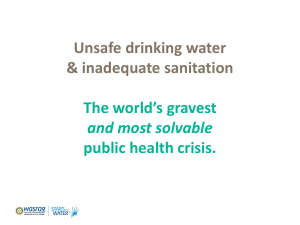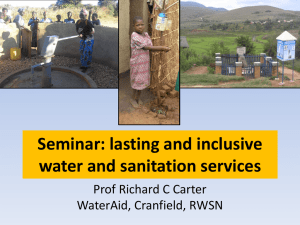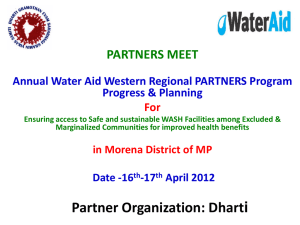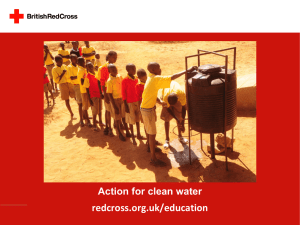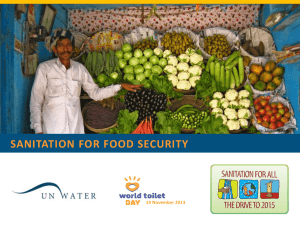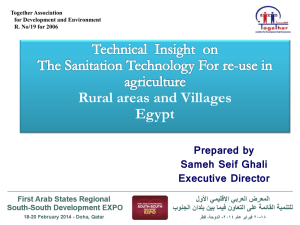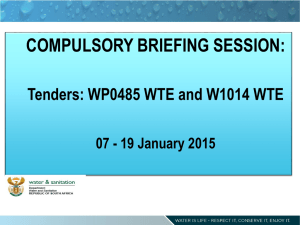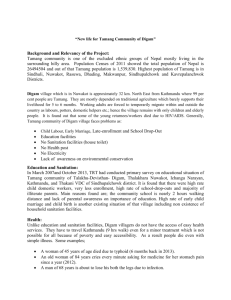Ensuring Better WASH Access to Poor and Vulnerable
advertisement
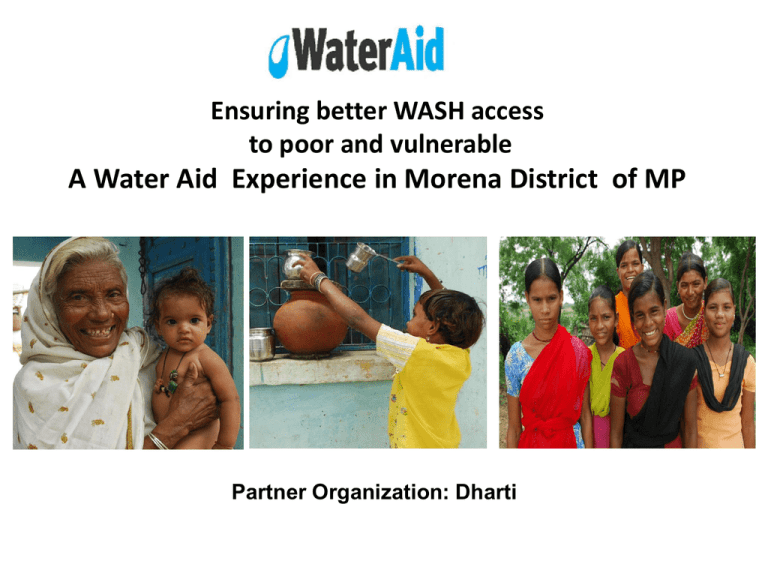
Ensuring better WASH access to poor and vulnerable A Water Aid Experience in Morena District of MP Partner Organization: Dharti Project Area-Amba block, Morena District Panchayat : 30 Total Village : 108 Total HH : 13000 Poor and Vulnerable Communities Panchayat HH Covered Total Population 30 7368 36893 Project Target Community Schedule cast, OBC, minorities & manual scavengers (Valmikis). Issues in the region • The project area, a part of Chambal region is characterised by ecological degradation (ravine affected), overexploitation of ground water, water scarcity in summer and social discrimination. • Deep rooted cast based system- leading to social exclusion and inequitable access to Water and sanitation • low sanitation coverage and usage • Inequitable access of services for example in one village Dimni 59% HH depend only 8 HP and 41% have 9 HP and 2 water Supply scheme) • Low capacity of Panchayat to execute water and sanitation programme Processes of Project implementation Community mobilization- Spreading the word around sanitation through 1-Interpersonal communication-it was done by trained ASHA worker and project staff through house to house visit, regular review meeting of community leaders and project team 2-Mass media mobilization- wall painting, celebration of important event like global hand WASH day, world toilet day and world water day, use of local cultural group and use of local print media 3-Ensuring school participation – enabling children to articulate WASH requirement Processes of Project implementation • Situational analysis for water and sanitation coverage through base line data collection • Vulnerability mapping through Participatory data collection to identify marginalised community 43% 57% Marginalised HH General HH Processes of Project implementation Developing Human Resources Under the programme several training packages were developed and training conducted to strengthen supply as well as demand side for better WASH coverage and access Training detail 2008-09 VWSC Training – R&R 193 ASHA Worker Training 93 AWW Training 79 Strengthening of HP Mechanic Training (Village 62 PRIs and VWSCs in Youth) programme Caretaker Training (Village Youth) 68 planning, Mason implementation Training(Village Mason) 114 and sustenance PRIs Training (PRIs Representative) 474 Water Quality Training 115 (Trained HP Mechanic & Caretaker) Teacher Training –from project villages Nil Training of masons, HP mechanics caretakers &WQ testing to strengthen supply chain for better service delivery 2009-10 2010-11 482 66 78 74 45 60 Nil 64 total 232 34 Capacity building of ASHA, AWW & School teachers in various aspects of programme motivation 741 and communication 907 193 157 136 113 174 1215 179 83 907 These are not merely numbers but a trained work force for sustained action Strengthening Supply Chain • Project has also promoted a block level resource center for better service delivery to water and sanitation facility • The center has all the information on the availability of mechanic and masons in the Ambah Block of Morena Processes of Project implementation Engaging and lobbying at Block and district level • Lobbying with line departments-Including PHED,TSC,RES, education and Health for timely fund flow and effective programme implementation • Formation of block level WATSAN Committee to engage and advocate with line departments ( group is also involved in Study on TSC, study on the availability and accessibility of water). • Organizing district level events to highlight water and sanitation issues and to showcase programme achievements- some of the events are World Water Day, Global Hand Wash Day and longest toilet queue • Engaging with elected representatives for effective programme implementation Processes of Project implementation Setting the pace for progress • The different hardware and soft ware training programmes have succeeded in giving programme a strong base • It is ASHA workers, school children, village youths, masons, HP mechanics with active support of Panchayat institutions and VWSCs who play a major role in motivating the community • This has resulted in actual action at field level in terms of actual construction of toilets and ensuring effective usage Project out put Sn Hardware Activity Total 1 2 3 4 5 6 8 9 11 12 54 86 126 1 1776 7 45 12 14 23 New Hand Pump Restored hand Pump Repair Hand Pump Piped water supply scheme Individual House hold latrine School Sanitary Block Compost Pit- NADEP Biogas Community Building Roof water harvesting Other structures-Soak pit The project intervention not only tried to build household toilets but adopted an integrated approach to create improved drinking water facilities Completed Hardware Activities 2008-09 and 2009-2010 Percent reach to marginaised community For project supported hard ware activities, well defined Indicators to select the marginalis ed groups/ families were in place 120 100 100 80 73 63 71 70 62 60 40 20 0 HP Restoration Repair New HP Installation Mini Water supply Scheme Toilets Community RWH The above trend clearly indicate that project has made a conscious effort to increase access of water and sanitation for the marginalised communities Project Outcome • Project Intervention able to reach marginalized communities despite deep rooted social biases. • The project intervention facilitated the good practices through community processes around water and sanitation issues. Villages like Mahadev ka pura, Kishanlal ka pura, Goath, Nayapura and Dimni now inspire communities from other places. • A trained cadre of youths, ASHA worker and empowered GPs can now take forward the processes of sanitation coverage on their own • Improved access of water has contributed towards personal hygiene and sustainability of sanitation. As Guddi Bai of Kishan Lal ka purva narrated the hardship of regular bathing and use of toilet when there was no hand pump, now with the assured availability of water not only personal hygiene has improved but usage of toilet is regularized in all the HH Sanitation access in project area learning • Identify appropriate simple, affordable decentralized sanitation systems and promote their adoption • Implementation of appropriate technologies with the participation of communities to be served increases the sustainability of created facilities • Focus on health and hygiene education can improve the maintenance and use of physical facilities. Hygienic behavior can also support the improvements brought about by the infrastructure. • If existing human resources or govt. extension workers are properly motivated and capacitated then they can contribute towards sustainability of physical facilities • Sustained efforts and proper capacity building of villages level institutions can improve coverage of sanitation
